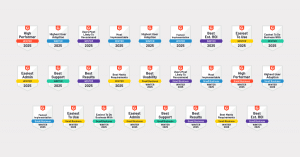For architecture firms, tracking project profitability and revenue is essential, but they don’t paint the full picture. A firm can be financially stable yet struggling with high turnover or unhappy clients. So, what should firms be measuring beyond the basics?
We met with Rodney Drayton, an accomplished architect and business leader, founder of Designing Insights, and member of the Blueprint Collective—to get his take on the key metrics firms often overlook.
Keep reading to learn Rodney’s insights as he discusses:
• The 3 less common metrics architecture firms should be paying attention to.
• Tips for turning data into actionable strategies.
• Keeping teams informed on performance metrics.
Financial benchmarks are important, but they don’t tell the full story. What other success indicators should firms be paying closer attention to?
There are three key areas that often get overlooked:
✔ People metrics: Employee engagement, retention, and leadership effectiveness.
✔ Thought leadership: Industry influence, thought leadership opportunities, and content strategy.
✔ Client relationships: The percentage of projects and revenue coming from repeat clients versus new business.
These areas provide a more complete picture of a firm’s health. A firm might have a slightly lower profit margin because it’s choosing to invest in its people or in building a long-term reputation as an industry leader. Those are smart trade-offs, but they won’t show up in a standard financial report which seeks to meet an industry benchmark.
Let’s start with people metrics. How should firms be measuring team health?
Architecture firms rely on talent. It’s a people business first and foremost, but firms often don’t track team well-being as rigorously as they track project budgets.
Employee engagement is a key indicator. Are people motivated to stay and grow within the firm? If engagement is low, firms risk losing their best talent or not getting the most impactful or innovative work from their staff.
Team leaders have a big role to play here, so leadership effectiveness is another important metric. Many architects move into management roles without formal training, so firms should be tracking how well leaders are supporting their teams as people first, then as great architects.
Retention trends also reveal a lot. High utilisation rates might look good, but if they’re leading to burnout and high turnover, that’s not sustainable. Firms that invest in their people—providing growth opportunities, supporting work-life balance, and developing strong managers—will see long-term gains in both employee satisfaction and project profitability and quality.
How do you measure something like thought leadership?
Awards can be valuable for market awareness, but they don’t always reflect real influence. Some firms spend thousands on submissions and marketing materials to win recognition, but that doesn’t necessarily mean they’re shaping the industry.
A better measure of thought leadership is earned influence. Are firm leaders being invited to speak at industry events? Are they publishing articles, whitepapers, or research that peers find valuable? Are they regularly quoted in media or referenced by clients?
The best firms don’t just design buildings—they drive conversations to impact what’s important to their clients. Their expertise is sought after, their insights are shared, and their brand becomes synonymous with innovation. That kind of industry presence has a far greater impact than any peer regarded award.
Client retention is another overlooked metric. How should firms approach it?
A high percentage of return business is generally a good sign—it means clients trust the firm and value the work being done. But if 90% of revenue comes from a few key clients in only one sector, that’s a risk. If one of those clients moves on or pauses projects for an indefinite period, the firm could be left scrambling.
Firms should be tracking both client retention and new client acquisition, by number and by revenue. A strong client base includes a mix of repeat work and new opportunities. Growth isn’t just about maintaining existing accounts and hoping that your clients are growing their business—it’s about expanding into new markets, developing new relationships, and ensuring the firm remains resilient even if one major client leaves.
The firms that do this well treat business development as an ongoing effort in addition to maintaining great existing relationships, not just something they focus on when work slows down.
Many firms experience data overload. How can they make sure numbers on a screen actually lead to action?
Many firms have dashboards filled with numbers, but that data often just sits there, leading to “analysis paralysis”. If a metric is off-track, leadership might acknowledge it, but then move on without making meaningful changes. This is where firms struggle—not with collecting data, but with using it effectively.
To make metrics useful, firms need to understand what they’re measuring and why. Do the measures on your dashboard relate back to your business strategy? If a firm is tracking utilisation, what’s the threshold where workload becomes a problem, and where is that non-billable time being spent? If profitability is declining, what specific steps are being taken to improve it? If business development slows down, is there a plan to address it and are you seeing it early enough to make an impact?
The firms that get this right aren’t just reporting on numbers—they’re using them to make strategy-aligned decisions. The key is not just monitoring metrics, but knowing when they should trigger targeted action.
How can firms share performance data with their team the right way?
Too often, performance data is reviewed at the executive level, while employees are left out of the conversation. When firms do share metrics with staff, it’s often in the form of a slide filled with numbers, without much explanation of where the data comes from, what it means or what’s expected next.
For data to be meaningful, employees need to understand why it matters and what they can do about it. If a key metric is off-track, leadership should clearly communicate how they’re addressing it and where employees can contribute. It’s not about overwhelming teams with numbers—it’s about giving them the right context and engaging their skills and influence to improve the outcomes.
Transparency also helps with accountability. If teams can see firm-wide goals and understand how their work contributes to success, they’re more likely to stay engaged. The best firms don’t just report on metrics—they use them as a tool for alignment, clarity, and continuous improvement.
Final Thoughts
Whilst important to maintain a place in market, profitability alone doesn’t define a successful architecture firm. A firm can be financially stable but struggling with disengaged employees, inconsistent leadership, or a dwindling client base.
The firms that thrive don’t just track numbers—they track what drives long-term success tailored to what’s important to them. From there, are employees motivated and invested in their work? Are leaders fostering growth and collaboration? Is the firm influencing the industry and attracting new opportunities? Are clients returning, or just one-and-done?
The best firms don’t just monitor data—they act on it, using it to strengthen their teams, build lasting relationships, and create a future as well-designed as the spaces they bring to life.
About Rodney Drayton
Rodney Drayton is an accomplished architect and business leader with extensive experience in the AEC industry. As the founder of Designing Insights, he seeks to help architecture firms bridge the gap between strategy and execution, driving business transformation and operational excellence.
With over 15 years in senior leadership in executive and operations roles, Rodney has overseen business transformation and growth initiatives whist also working with government and institutional clients on major projects exceeding $4 billion.
Having worked in Australia, the US, and UK, his expertise spans digital transformation, workforce optimisation, and strategic architectural advice on large-scale public projects. A recognised leader in business and technology integration, Rodney empowers firms to scale, innovate, and create lasting impact.
The Blueprint Collective: A Community for A&E Innovators
Rodney Drayton and this article are part of the Blueprint Collective, a community of architects and engineers driving industry innovation. Members gain access to exclusive insights, networking, and promotional opportunities, including benchmark reports, speaking engagements, and industry events. Through monthly discussions, they share expertise and shape the future of A&E. Learn how to join the Blueprint Collective here.




